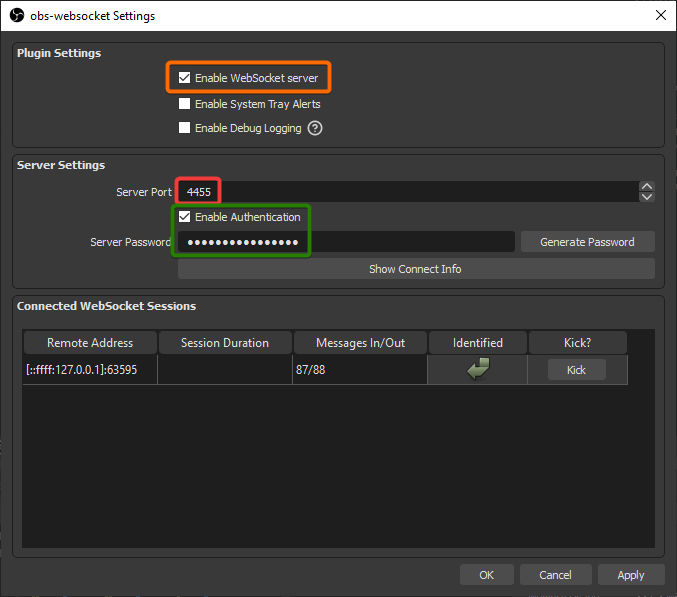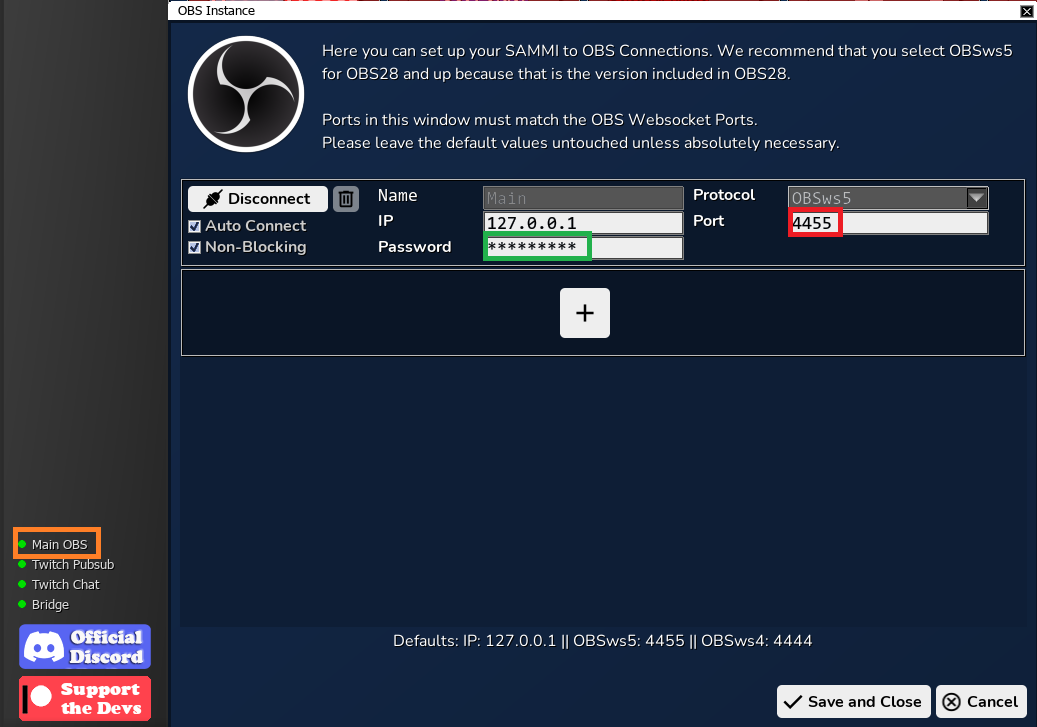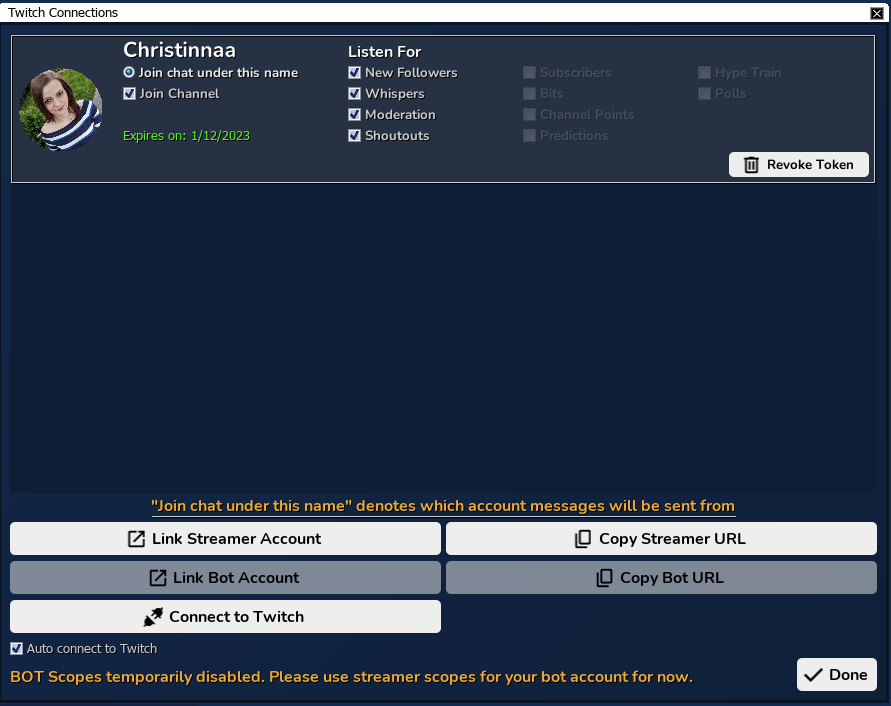Step by step tutorial
Welcome to SAMMI and the world of endless possibilities!
On this page, we will walk you through a step by step tutorial on how to set up SAMMI, and connect it to OBS and your Twitch account. You will also learn how to create your first button, add a command and trigger it via Twitch chat.
1. Install all dependencies #
- Download and install OBS Studio. As of now, SAMMI does not support other streaming software.
- As of OBS Studio v28, there is no need to download a separate OBS Websocket plugin as it already has OBS Websocket 5.0 built into it. This is how SAMMI communicates with OBS Studio. If you are running OBS Studio version 27, you will need to download and install OBS Websocket 4.9.1
- If you are on OBS v28, and you want to use extensions and plugins that are NOT compatible with OBS Websocket 5.0, then you can download the OBS Websocket 4.9-compat for backwards compatibility. However, this means you will need to set up two instances of OBS in SAMMI, one using 5.0 and one using the 4.9-compat version.
2. Download SAMMI #
We recommend selecting 64bits release. SAMMI 2022.5.0 is the final release that has 32-bit (x86) support.
Extract the zip folder and unpack the files to a location on your PC. Windows 11 should let you right click and extract all from zip files without 3rd party tools, otherwise you can use trusted software like WinRar or 7Zip to extract the files.
3. Launch SAMMI #
Navigate to the unpacked folder and launch SAMMI Core.exe. Allow the app through the firewall if there’s a prompt and press yes if you get an alert your decks are empty (this is fine since it’s your first time launching SAMMI).
4. Connect SAMMI to your OBS #
-
In your OBS go to Tools-Websocket Server Settings. Make sure
Enable Websockets Serveris checked.
We recommend uncheckingEnable Authenticationfor easy setup.
If you wish to use a password for your OBS connection, you must also configure it in your SAMMI - OBS Connections settings.
OBS Websocket Settings
- In your SAMMI, click on OBS Connections at the bottom menu. Protocol should be set to
OBSws5unless you’re configuring another OBS connection to useOBSws4as well.
If you used a password for OBS in the step above, make sure the passwords match. -
Click Connect. You should see the status indicator for
Main OBSin the left bottom corner change from red to green.
OBS is connected
5. Add Bridge to your OBS Dock #
In your OBS menu navigate to Docks - Custom Browser Docks….
Your new Dock Name can be Bridge and the URL will be the path to the bridge.html file located in your SAMMI/bridge folder. You can retrieve it by clicking on Bridge - Copy Full Path in your SAMMI.
Press apply and you should see your new dock. If it does not pop up for some reason, you can always go to View - Docks - Bridge.
Fit your new dock somewhere in your OBS screen as you see fit.
6. Connect Bridge to SAMMI #
In your Bridge-status tab (in our OBS dock), you can now modify your connection settings.
Default IP address for SAMMI is always 127.0.0.1 and port is always 9425. Leave all values as the default values.
You must fill out the password if you decided to use one in SAMMI-Settings menu.
Note that you only need to do this once, as your Bridge will remember the previous settings and will attempt to auto connect next time.
7. Link your Twitch account #
Linking your Twitch account to SAMMI is a necessary step if you want to be able to listen to alerts and control your Twitch via SAMMI.
You can link multiple Twitch accounts, however in this tutorial we will focus on connecting your main account.
- In your SAMMI click on either Link Streamer Account (if linking an account you use to stream with) or Link Bot Account (if linking an account you use as your bot, for example for posting chat messages).
- Press Authorize and wait to be redirected again to see
All good, you can go back to SAMMI nowmessage in your browser. - Back in SAMMI you should now see your Twitch account in the list!
- You can now optionally check which events to listen for and whether you want to Join Chat Channel for this particular Twitch channel.
- You want to also check
Auto connect to Twitch, else you will need to always press the Connect Chat button every time you open SAMMI to be able to receive and send chat messages from SAMMI. -
Press Connect Twitch to connect to Twitch.

Active Twitch Connection
8. Create your first button #
In this part of the tutorial we will learn how to create a button with a simple command and add a Twitch chat trigger to it. You can follow the text instructions or watch a short video for each step.
-
In your SAMMI, click on Add New Deck button. You should see a newly created blank deck named Deck 1. Double click on it.
-
This empty grid is your deck where you can create new buttons. Right click anywhere in the empty area and select Create Button or simply double click (video example shows both options, you can delete the extra button). A new empty button will be created.
-
Right click on the empty button you just created - Add Commands or double click on it.
-
Click on the + symbol. A dropdown menu will appear. Click on Twitch Commands and select Twitch: Send Chat Message (you can also just start typing message in the search box).
- Populate the command’s fields.
- Message - Put a random text in there. For example
Hello World!. - Channel Name - Leave empty (will use your default Twitch channel)
Press Save and Close once finished.
- Message - Put a random text in there. For example
- Back in our deck, right click on the new button - Edit Triggers. This is where you can attach any event to trigger your button.
- Click on the + sign and select Twitch Chat from the dropdown menu.
- Remove the
*in the Message field and populate it with!testinstead.
Press Save
-
Optionally change button’s text or appearance by right clicking on the button and selecting Edit Appearance.
-
Back in your deck, press Save
We have now created a button that will send a chat message Hello World anytime it’s pressed. We have also created a Twitch chat trigger which will execute the button automatically any time someone types !test in your Twitch chat.
Trigger the new button manually from SAMMI Deck #
There are several ways how you can trigger a button. One of them is triggering it from your SAMMI Deck.
- Open SAMMI Deck by navigating to SAMMI - SAMMI Deck - Open SAMMI Deck.
-
Once it launches, you will see connection settings. As we are just keeping everything at default in this tutorial, you can simply press Connect. Selected deck should be
Deck 1. Press Load Deck and you should see your newly created button. -
While looking at your Twitch chat of the Twitch account you just linked in SAMMI in the previous steps, click on the button in your SAMMI Deck. It should send a
Hello World!message to your chat!
Trigger the new button manually from Edit Command Window #
If you’re just putting together a new button, it’s often easier to trigger it directly from your SAMMI, as this allows you to keep modifying the button commands without all the extra steps of saving the button and then pressing it in your SAMMI Deck.
- Navigate to your button’s commands inside SAMMI.
-
Press Run Button. You should see the same
Hello Worldmessage in your Twitch Chat.
Trigger the new button automatically via your Twitch Chat #
Do you still remember the Twitch chat trigger you configured for your button? If you followed the tutorial, it should be !test. This means that everytime anyone types !test in your Twitch Chat, the button should get automatically triggered.
- Type
!testin your Twitch Chat while looking both at your chat and SAMMI Deck. Two things should then happen:- You will see the button in your SAMMI Deck blink, just like when you manually pressed it with your mouse earlier.
- SAMMI will respond back with
Hello Worldmessage in your Twitch Chat.
Now you have learned how to create a button, add a command and trigger it via Twitch chat! You can find more information about the individual components, commands and triggers in the next sections of the documentation.